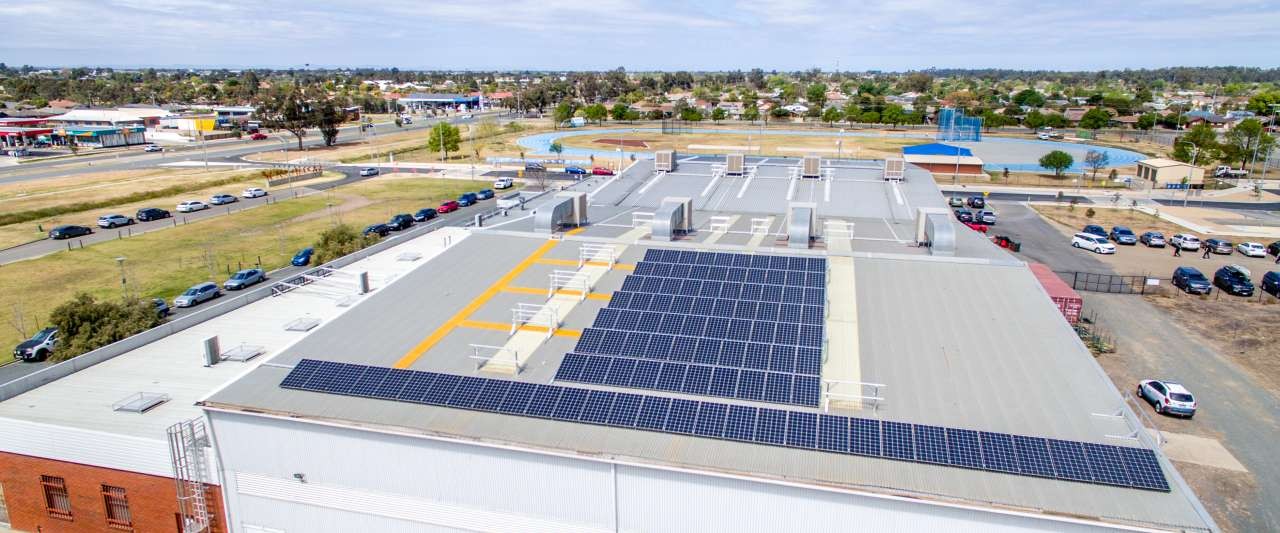Energy

Council is committed to reducing our energy use to reduce our greenhouse gas emissions, and to reduce costs.
The role of energy in climate change mitigation
The largest cause of climate change is from the burning of fossil fuels (gas, coal, petrol and diesel) for energy, which releases carbon emissions into our atmosphere, trapping heat from the sun, leading to climate variability and gradual overall warming over time.
Climate change mitigation refers to reducing the causes of climate change. Using less energy, and using renewable energy (e.g. solar and wind) instead of fossil fuel energy, reduces the greenhouse gases released into our atmosphere. All carbon emissions are contributing to climate change, so the quicker emissions are reduced, the less impact they have on our climate.
Find out more about climate change adaptation and the Climate Emergency.
Energy management at Council
The use of fossil fuels for energy emits significant amounts of greenhouse gases which contribute to climate change. Energy use also results in direct financial costs to Council, including for the electricity, gas, petrol and diesel used to power buildings and fleet. Reducing energy usage reduces costs, and using renewable energy can be cheaper than using fossil fuel energy, creating a win-win situation.
Council is committed to reducing its energy use to reduce greenhouse gas emissions, converting energy to renewable sources, and reducing costs for ratepayers.
2030 Zero Emissions Target and Plan
Council has developed and adopted a 2030 Zero Emissions Plan for its internal operations and services. This follows the adoption of a 2030 Zero Emissions Target at the March 2020 Ordinary Council Meeting.
The plan outlines the key areas Council will focus on to transition to net zero emissions by the 2030, and the actions it will undertake to reach the target for all its operations and services. The 63 Actions for implementation fall under seven themes - Zero Emission Facilities, Fleet and Plant, Towards Zero Waste to Landfill, Goods and Services, Governance, Our Council and Carbon Sequestration.
December 2021
100% Renewable Electricity – Victorian Electricity Collaboration (VECO)
Since July 1 2021, Council’s electricity is 100% renewable, thanks to the VECO project, which is a collaboration of 45 councils around Victoria. This eliminates all of Council’s electricity emissions, and reduces electricity costs by approximately 10% annually. This project highlights both the environmental and financial benefits of acting on climate change and reducing emissions.
Energy Reduction Plan
Council adopted the Greater Shepparton City Council Energy Reduction Plan in 2015. The plan sets a target of 20% reduction of Council energy use and cost over 2013/2014 figures by 2020. A number of actions in the plan will help us to reach this target such as large-scale solar generation on Council’s biggest energy consuming buildings; implementing at least 50% of past energy audit recommendations with a payback period of less than 7 years; and changing the way we undertake capital works programs. View the Plan here:
Solar PV installation program
Council has installed over 500kW of solar PV to council facilities to reduce greenhouse gas emissions and energy costs.
| Year | Site | Solar PV Size |
|---|---|---|
| 2018 | Welsford St Office | 90kW |
| Shepparton Sports Stadium | 30kW | |
| 2019 | Doyles Road Complex (Depot) | 99kW |
| Mooroopna Community Hub | 56kW | |
| 2020 | Aquamoves | 99kW |
| Shepparton Saleyards | 55kW | |
| 2021 | Shepparton Business Centre | 30kW |
| North Shepparton Community Hub | 40kW | |
| 2022 | Tatura Park | 30kW |
| Arthur Dickman Children's Centre | 25kW | |
| Nancy Vibert Children's Centre | 14kW | |
| Rodney Neighbourhood Kindergarten | 12kW | |
| GV U3A | 6kW |
Electric Fleet Vehicles
Council has integrated over 15 fully electric vehicles (EVs) and plug-in hybrid electric vehicles (PHEVs) into its passenger pool fleet, and introduced one fully electric truck to its heavy fleet to reduce greenhouse gas emissions and pollution. These vehicles are powered by 100% renewable electricity from onsite solar PV systems, using AC and DC chargers.
The remainder of Councils passenger pool fleet is composed of fuel efficient, hybrid vehicles that reduce emissions and fuel costs compared to standard passenger vehicles.
Public electric vehicle charging stations
Council has installed two 50kW DC fast charging stations in Shepparton and Mooroopna as part of the Charging the Regions – Stage 2 project. There are two bays located in the Fraser St carpark in Shepparton, and two bays located in the McLennan St median strip carpark in Mooroopna, which are accessible via the Evie payment app. The chargers are powered by renewable electricity, allowing both local and visiting drivers to charge their vehicles emissions-free.
Council has also installed 4 x AC Electric Vehicle chargers at the new Shepparton Art Museum. These chargers are free for all drivers to use.
Energy audits and efficiency upgrades at community facilities
Council received funding through Sustainability Victoria – Community Climate Change and Energy Action program to complete Type 2 energy audits at:
- Bangerang Cultural Centre
- Murchison Community Centre
- Tatura Community House
- Tatura Ballantyne Centre
- Toolamba Community Centre
Energy efficiency works were then undertaken in 2023 at the Toolamba, Murchison and Tatura sites, co-funded by Council and Sustainability Victoria through the Community Climate Change and Energy Action (CCCEA) Round 3 program.
Site improvements included:
- removal of old gas heaters and replacement with energy efficient split-systems
- installation of energy efficient appliances
- replacement of gas cooktops and ovens with electric ovens and induction cooking units
- draught sealing works
- installation of blinds
These works have reduced carbon emissions while also improving the comfort of the sites for the community.
Cities Power Partnership
Council is a member of the Cities Power Partnership – a network of Australian councils working to support renewable energy, energy efficiency, sustainable transport and collaboration. Visit the Cities Power Partnership website for more information.
Energy efficiency – What you can do
Reducing your energy use benefits both your budget and the environment. By using energy efficient appliances and only using the energy you need, you reduce your consumption costs on your energy bills, and your carbon emissions that contribute to climate change.
Visit the links below to learn more about how you can improve your energy efficiency in your home and business.
- YourHome
Australia's guide to environmentally sustainable homes - Renew (formerly Alternative Technology Association)
Inspiring people to live sustainably in their homes and communities - Your Energy Savings
Information about saving energy, saving money and available government assistance - Australian Government Department of Environment and Energy
Join the clean energy future and make your home all-electric. Use this plan to prepare so that when appliances need replacing, you’re ready to make the switch. Your household could save up to 75%* per year on your bills.
Home Energy Efficiency Toolkit
Council has teamed up with GV Libraries to offer the Home Energy Efficiency Toolkit to the community for borrowing. This kit is designed to help you identify issues that are affecting the energy and water efficiency of your home.
Each tool is designed to give information about some important aspects of your home’s efficiency, which can help you to work out what steps you can take to reduce how much energy and water you use saving you money, and reducing your greenhouse gas emissions at the same time.
What's in the Toolkit?
This kit contains the following tools:
- Energy Saving thermometer
- PowerMate Lite Energy Meter
- Lux Meter/light Level Meter
- Water flow measuring cup
- Thermal Camera
- Instruction guide
Where to borrow the kits
Goulburn Valley Libraries
- Shepparton: 41-43 Marungi Street, Shepparton
- Mooroopna: 9-11 Morrell Street, Mooroopna
- Tatura: 12-16 Casey Street, Tatura
Renewable Energy
Solar Photo Voltaic (Solar PV)
Powering your home with renewable energy can be an effective way of reducing both your energy costs and carbon emissions.
If you are considering installing solar, visit the Solar Victoria website for Solar PV guides, resources and links to current rebates.
Goulburn Murray Solar Savers
Goulburn Murray Solar Savers is a local government initiative helping households and businesses to install quality and affordable rooftop solar, batteries, heat pumps and heating and cooling systems. This program will help residents and businesses reduce energy bills and future-proof against increasing energy costs, while supporting a transition to clean, renewable energy by providing free advice and trustworthy quotes.
Learn more and submit your EOI here.

